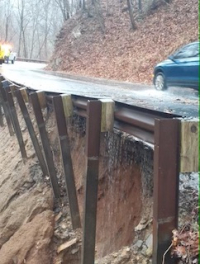Southwestern Commission: Collectively leading the region for 50 years
 One day they were operating out of the community center building in Sylva and the next they were moving into a singlewide trailer in Bryson City. Some years federal grant money rolled in hand over fist, and other years they fought tooth and nail for highly competitive grants for their communities. They’ve seen years of unchecked growth and years of economic stagnation.
One day they were operating out of the community center building in Sylva and the next they were moving into a singlewide trailer in Bryson City. Some years federal grant money rolled in hand over fist, and other years they fought tooth and nail for highly competitive grants for their communities. They’ve seen years of unchecked growth and years of economic stagnation.
Southwestern Commission was formed in 1965 to act as a conduit for local governments to receive federal funding for economic development, whether it’s for infrastructure, business development and training or other services. The organization also provides monitoring and oversight of grants and funding given to governments.
Over the past 50 years, the Southwestern Commission has been through several transformations and continues to evolve along with the needs of the seven westernmost counties in North Carolina. SWC — a regional council of government — has the simple mission of helping the local governments in its district accomplish their goals.
SEE ALSO: SWC initiatives give unified voice to the region
“We don’t have a strategic plan because we help the local governments implement their own strategic plan,” said Ryan Sherby, SWC’s executive director.
The commission’s work runs deep throughout the region, and whether they realize it or not, residents would be hard pressed to point out a piece of major infrastructure, an economic development project or a local government program implemented in the last 50 years that wasn’t somehow supported by SWC.
Related Items
Asking Sherby or past SWC leaders what their most important project was is like asking a parent to choose their favorite child. Each new piece of infrastructure helped move the entire region forward and each grant awarded helped a local government better serve its community.
Beginning in 1965, SWC has had its hands in creating a library system, community colleges, finding funding for water and sewer plants, airports and community centers, expanding community hospitals, establishing emergency management programs and much more.
Former SWC executive director Bill Gibson, who spent 40 years with the organization, said the commission’s role was always a supportive one — being the facilitator for projects and often being the facilitator to work out a problem between two or more governments.
“Processes were always the most important thing — motivating locals to think beyond the gap of the mountain where the next county started,” he said. “We had a lot of situations where we facilitated interlocal cooperation around common problems and opportunities.”
As the region’s goals change, SWC’s services change to meet those needs. SWC was focused on securing federal funding for infrastructure projects during the early years, but Sherby’s focus during the last few years has been on regional long-range planning and pooling limited resources. County and town officials can get tunnel vision when it comes to dealing with challenges in their communities without realizing the county next door is facing the same problem. SWC allows county and town governments to come to the same table and find solutions.
“We’re in a unique position to understand the culture and geography because we’re looking at it from 30,000 feet while others are looking at it much closer,” Sherby said.
Historical perspective
During the “heyday” of the Southwestern Commission, there was plenty of money funneling in from different agencies.
“We couldn’t spend it as fast as it was coming in and now it’s fiercely competitive,” Sherby said of the early days.
Similar councils of government were being established throughout the country as state legislatures and the U.S. Congress were creating thousands of grant-in-aid programs and distributing billions of dollars to implement them.
“In the 60s when the federal government started helping local governments, they needed some entity to manage those funds so they didn’t have to contract with every local agency,” said Sarah Thompson, SWC director of planning and development. “And it’s evolved over the years to fill a lot of roles.”
Gibson started his long career with the commission shortly after returning from military service in South Korea. He was one of half a million soldiers returning home about the same time, and he landed a temporary job with SWC in 1973 to help implement a program through the U.S. Department of Labor to reintegrate the troops into the workforce.
In 1976, he became the executive director — a position he occupied until he retired in 2013. Gibson witnessed many changes in the region and the organization during those 40 years.
“When I started, the region was a whole lot more like the region I grew up in than the region it was when I was there or the region like it is today,” he said. “It was still deep Appalachia.”
Vicki Greene started working at SWC around 1975 and retired in 2011 to run for a commissioner seat in Jackson County. With a master’s degree in public administration, she returned to Western North Carolina and landed a job as a community planner for SWC.
Greene remembers the early days when communications were slow with limited technology. Most correspondence between counties was done via written letters — a far cry from how the commission operates today.
“When I first started working, there was no Internet,” she recalled. “We did have a fax machine, but we had to run off a guide for local officials on a mimeograph machine.”
It wasn’t just technology that was lacking. It was a time when Western North Carolina was in desperate need of water and sewer infrastructure, roadways, airports, vocational schools and community colleges. In an effort to carry out former President John F. Kennedy’s promises of a “Great Society,” President Lyndon Johnson’s administration pushed through a number of programs to help rural America with infrastructure projects.
Federal and state grant money was readily available for those local governments first to the plate to receive it. And Gibson always made sure his region was first in line.
“The reality was if we weren’t working overtime, we were denying someone — one of our counties or towns — the opportunity to get 85 to 90 percent outside money for a project,” Gibson said. “Of course it was still tax funded stuff but it always redistributed for rural development.”
Say what you will now about the programs and the distribution methods, but without those programs, Western North Carolina wouldn’t have the strong foundation it does today.
“Some called it a pork barrel — I called it catching up and that’s the way a majority of folks looked at it,” Gibson said. “What we worked on was a range of community development projects — starting with basic infrastructure.”
Gibson and Greene also built long-lasting relationships during their tenure that Sherby continues to nurture today. They were locals and spoke the language of their region. Greene, who has known Gibson since their high school days, said the quiet young man she knew changed into a tremendous leader who had the gift of being able to converse and relate with anyone — from local farmers to legislators in Raleigh.
“Somewhere along the way he morphed into the Bill Gibson who can tell you how to make a watch when you ask for the time,” Greene joked.
Rolling with change
During the early years of Gibson’s leadership, a good portion of the commission’s funding went toward infrastructure — water, sewer, roads and telecommunications.
Gibson can’t point to any sudden shift that has molded the organization into what it is today. He said it was a gradual change throughout the years as state and national politics changed. With each new administration — on the local, state and federal level — came new goals, nixed funding and a new set of challenges.
On the other hand, Greene recalls a big shift that shaped SWC’s efforts.
In Ronald Reagan’s 1981 State of the Union address, he promised to terminate the Economic Development Administration and other governmental entities that SWC received a majority of its funding from.
“He did everything but say ‘Vicki go home,’” Greene said. “Both agencies are still alive today, but they don’t have the kind of money they used to have for infrastructure projects.”
Sherby, who has been the executive director for about three years, said the focus has changed as the region has changed. There are many programs SWC has been tasked with administering that have been taken away and new ones that have been added. At one point things like child services and emergency management were under the commission, but they have since been turned over to the counties.
Gibson said that happened often — SWC would start a program or take over a program and would make sure it was running efficiently before turning it over to a local government.
“I always felt our mission was to help local government fix something until they could do it well or better by themselves — then we moved on to something else,” he said.
All of the counties in the region now have four to six commissioners or aldermen on the board plus a professional full-time manager, but Gibson said that wasn’t the case in the early years. Counties typically had three commissioners, and the chairman often served as the county manager. He said Canton was the only town he could recall having a professional town manager back then. So SWC stepped into that role when needed.
“We would help commissioners work through situations they weren’t prepared to handle,” Gibson said.
Gibson said trying to find common ground in the region between Democrat and Republican leaders was never an issue in his opinion — even with new leaders coming in every few years.
“At least half if not 75 percent of county commissioners were Democrat — but very conservative — and the Republicans — one couldn’t tell the difference,” he said. “They were all pro-county, fiscal conservatives trying to do what was best for the county. You didn’t see any political ideologists.”
Gibson and Greene saw their fair share of changes on every level, and they understood that it came with the job. When Gibson reached his retirement age, he could already see another political shift in policy brewing at the state and federal level and had to ask himself an important question.
“I had to look at myself and ask, ‘do you really want to go through another one of these?’ and the answer was no — the commission needs a fresh mind and new energy,” Gibson said.
Spreading the word
Mention Southwestern Commission to someone on the street, and it is likely they’ve heard it mentioned before but will probably have no idea what the organization does.
Gibson said that isn’t a new problem. It isn’t that SWC isn’t as prominent as it once was — the stealth qualities of SWC have historically been intentional. SWC considers itself an extension of the local governments it works for and would rather the elected officials receive the credit.
“To some degree that’s by design — we usually ran pretty deep and pretty dark in terms of always following the lead of the elected and appointed officials,” Gibson said. “They are the guys and ladies who stand for election and get called in the middle of the night. It’s seldom they get calls when things go right.”
Gibson also sees that paradigm changing and now thinks it may be time for SWC to be better known by the people it serves in the region. Local government requires more public input now than it used to, and with limited funding available from the state and federal government, counties need more support from constituents in order to fund projects.
With new leadership coming into local governments every few years, Thompson said outreach and education is a large part of what SWC does to let counties and municipalities know what services the organization can provide.
“It’s kind of a road show — we remind them of what we do,” she said. “Some have more staff capacity and some get used to relying on us.”
Sherby said the commission conducts a service survey to ask local governments what services the organization should be providing.
“It’s important for us to stay current on their current goals when new people come in,” he said. “They own the regional council — it’s a shared organization and we’re basically an extension of county and city staff.”
Macon County Commissioner Ronnie Beale is very familiar with the work SWC does. He is active on the board of directors and on the transportation planning committee. With changes in how the North Carolina Department of Transportation is prioritizing projects to receive funding, he said SWC’s transportation planning would be critical in the coming years.
“Southwestern Commission has been a friend to all the far west counties in many ways throughout the years,” he said. “If it hadn’t been for them, we wouldn’t have secured money for infrastructure and wouldn’t have the long-range planning that’s benefited Macon County in many ways.”
New leadership
Gibson’s retirement marked the end of an era for the organization. Gibson and two other key leaders — Greene and Mary Barker — all retired within three years of one another.
“A changing of the guards was taking place,” Thompson said. “They had 100 years of experience between the three of them.”
The loss was huge for the organization’s continuity, but Thompson said the transition was as smooth as it could be with existing staff stepping into the vacant roles.
Sherby has worked for SWC for eight years. Five of those years were spent as the transportation planner before he was chosen to lead SWC into its next phase. For someone who is a “transplant,” Sherby took it as a good sign that the SWC board of directors selected him to lead the organization.
That alone was a significant change given that Gibson was a homegrown product of Western North Carolina. Gibson was a mentor to Sherby when he began at SWC and said he is very proud of the work he’s been doing since taking the helm.
“Every time I walk in the office, which isn’t very often now, I swell with pride upon seeing where they are and what they’re doing and the kinds of relationships they’ve maintained,” Gibson said. “I’m really happy and proud to look back and see the organization is in better hands than if I had stayed.”
Waynesville Mayor Gavin Brown, who served as chairman of the SWC board of directors in 2013-14, agreed that Sherby was the right person to move the organization forward.
“Ryan is working on what Bill created — his way of doing business is different than Bill’s, but the result is the same,” Brown said. While Gibson may have built the structures and relationships throughout the region, Sherby will continue to maintain those relationships and plan for future infrastructure.
“Ryan brings a lot of passion and he understands the politics of what we do, and we appreciate all the work he does for us,” Brown added.
Planning for the future
Even before Sherby moved into the executive director position, SWC’s focus was shifting to more regional and long-term visioning and planning. For many years before the recession, the region saw unbridled growth without much big-picture planning in mind.
Local governments didn’t have the development standards and procedures in place that many of them do now. The second-home industry was booming in the region and the health department was continuously six months behind on inspections.
“We wanted that growth, but we weren’t ready for it,” Sherby said. “We have to figure out how do we manage that kind of growth.”
Greene, who worked for SWC for 36 years in many capacities, said she thinks Jackson County has been at the forefront of planning for the future by implementing development standards for the county, having planning councils in several communities and passing ordinances to protect the county’s natural resources.
These days it’s harder to secure funding and implement a large-scale infrastructure project without a sound plan in place. Thompson said most grant applications want you to be able to show the need for the proposed project.
“They want to know ‘is this something that region wants or someone grabbing an opportunity?’” she said.
Thompson said the region is now at a point where sustainable planning is critical for the region’s future. This is where SWC’s Opt-In and Mountain West Alliance initiatives play a key part in moving the region forward in a collective direction (See related story on page 7).
“There’s a lot more planning being done in the region than we’ve ever done in the past,” Thompson said.
Bringing high-speed Internet is another challenge being discussed by SWC. While the demand for broadband is high in the region, the challenge is getting private companies to invest the infrastructure to make it happen.
“With the dispersed settlement pattern in Western North Carolina, we don’t have the density to put in costly infrastructure because the payback is 30 years down the road,” Sherby said. “Companies want a three-year payback. That’s a huge challenge, but if we can light up the region with high speed Internet, it would change everything.”
Sherby will be the first to admit that one of SWC’s challenges is getting people involved in the process. While people often peek out when a controversial issue comes up, he would like to see more people involved throughout the planning process.
“There’s a sense of apathy in the region — I don’t think there is enough civic engagement,” he said. “Local government affects us much more than federal government. We need the younger generation to run for office to bring a new energy into those entities — people with a willingness to explore and tackle the important issues.”
Gibson agreed that the commission would stay relevant moving forward into the next 50 years only if the communities and the powers that be in Washington, D.C., continue to see the value in its services. He said SWC provides the two things needed to accomplish something — fiscal capital and relationship capital.
“That’s what in my opinion the commission provides people, and it’s an organization everyone across the public policy spectrum trusts,” he said.
The mission
The mission of the Southwestern Commission is to improve the quality of life in its seven-county service area by assisting local governments in reaching their goals.
Southwestern Commission provides the following services:
• Workforce development
• Business services
• Aging initiatives
• Transportation planning
• Community planning
• Strategic plans
• Project development
• Project funding
• Project management
• Grant writing
• Grant administration
• Facilitation service
• Leadership training
• Technical assistance
• GIS mapping
• Economic development
• Hiring/selection assistance
Organizational structure of SWC
• All counties and towns in the region are dues-paying members
• SWC board of directors is made up of leaders from each county and municipality.
• The organization has five divisions — Agency on Aging, Community and Economic Development, Land and Water Conservation, Transportation Planning and Workforce Development.
• SWC has received federal funding for the past 50 years to implement these core operation programs. While that funding has been steadily funded, available funding for community and economic development public projects has steadily decreased over time.









